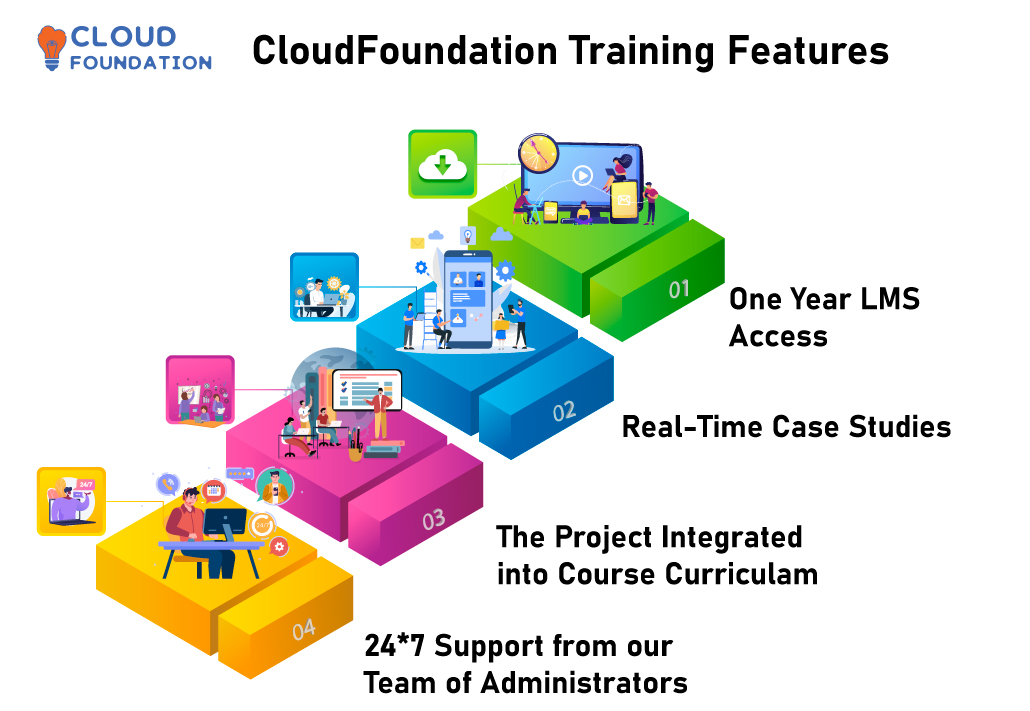CISSP Training
⏰24 hours | ▶️ 24 Videos | 📣 11405 Participants | 🎓 4527 Reviews | 4.8 ⭐⭐⭐⭐⭐
Choose a Plan that Works for You
Self Paced
- Advanced sessions
- Interview Q&A
- Free study Materials
- Premium Technical support
Instructor Led Live Training
- Live Instructor
- Advanced sessions
- Interview Q&A
- Premium Technical Support
Corporate Training
- Live Instructor
- Advanced sessions
- Interview Q&A
- Premium Technical Support
Upcoming Batches PST
Weekday
| June 11(1 HR A DAY) |
| 06:00 PM PST |
| Enroll Now → |
Weekday
| June 27(1 HR A DAY) |
| 06:00 AM PST |
| Enroll Now → |
Weekend
| June 21(1 HR A DAY) |
| 06:00 PM PST |
| Enroll Now → |
Upcoming Batches IST
Weekday
| June 12(1 HR A DAY) |
| 07:30 AM IST |
| Enroll Now → |
Weekday
| June 27(1 HR A DAY) |
| 07:30 PM IST |
| Enroll Now → |
Weekend
| June 22(1 HR A DAY) |
| 07:30 AM IST |
| Enroll Now → |
Course Description
CISSP – The Certified Information Systems Security Professional (ISC)² Training that everyone is looking for now.
CISSP course is beneficial for IT security Professionals having three or more years of experience.
You can get trained on the CISSP with the help of Online classes conducted by Certified Instructors.
It is the most recommended certificate for IT Security employees to succeed in their careers.
Make your learning effective with online training and clear your queries instantly with the trainers or any assistance you need visit our support chat to resolve it within no time.

Course Content
1.Security and Risk Management
1.1 Understand and apply concepts of confidentiality, integrity and availability
1.2 Evaluate and apply security governance principles
- Alignment of security function to business strategy, goals, mission, andobjectives
- Organizational processes (e.g., acquisitions, divestitures, governance committees)
- Organizational roles and responsibilities
- Security control frameworks
- Due care/due diligence
1.3 Determine compliance requirements
- Contractual, legal, industry standards, and regulatory requirements
- Privacy requirements
1.4 Understand legal and regulatory issues that pertain to information security in a global context
- Cybercrimes and data breaches
- Licensing and intellectual property requirements
- Import/export controls
- Trans-border data flow
- Privacy
1.5 Understand, adhere to, and promote professional ethics
- (ISC)² Code of Professional Ethics
- Organizational code of ethics
1.6 Develop, document, and implement security policy, standards, procedures, and guidelines
1.7 Identify, analyze, and prioritize Business Continuity (BC) requirements
- Develop and document scope and plan
- Business Impact Analysis (BIA)
1.8 Contribute to and enforce personnel security policies and procedures
- Candidate screening and hiring
- Employment agreements and policies
- Onboarding and termination processes
- Vendor, consultant, and contractor agreements and controls
- Compliance policy requirements
- Privacy policy requirements
1.9 Understand and apply risk management concepts
- Identify threats and vulnerabilities
- Risk assessment/analysis
- Risk response
- Countermeasure selection and implementation
- Applicable types of controls (e.g., preventive, detective, corrective)
- Security Control Assessment (SCA)
- Monitoring and measurement
- Asset valuation
- Reporting
- Continuous improvement
- Risk frameworks
1.10 Understand and apply threat modeling concepts and methodologies
- Threat modeling methodologies
- Threat modeling concepts
1.11 Apply risk-based management concepts to the supply chain
- Risks associated with hardware, software, and services
- Third-party assessment and monitoring
- Minimum security requirements
- Service-level requirements
1.12 Establish and maintain a security awareness, education, and training program
- Methods and techniques to present awareness and training
- Periodic content reviews
- Program effectiveness evaluation
2.Asset Security
- Data classification
- Asset Classification
2.2 Determine and maintain information and asset ownership
2.3 Protect privacy
- Data owners
- Data processers
- Data remanence
- Collection limitation
2.4 Ensure appropriate asset retention
2.5 Determine data security controls
- Understand data states
- Scoping and tailoring
- Standards selection
- Data protection methods
2.6 Establish information and asset handling requirements
Domain 3: Security Architecture and Engineering
3.1 Implement and manage engineering processes using secure design principles
3.2 Understand the fundamental concepts of security models
3.3 Select controls based upon systems security requirements
3.4 Understand security capabilities of information systems (e.g., memory protection, Trusted Platform Module (TPM), encryption/decryption)
3.5 Assess and mitigate the vulnerabilities of security architectures, designs, and solution elements
- Client-based systems
- Server-based systems
- Database systems
- Cryptographic systems
- Industrial Control Systems (ICS)
- Cloud-based systems
- Distributed systems
- Internet of Things (IoT)
3.6 Assess and mitigate vulnerabilities in web-based systems
3.7 Assess and mitigate vulnerabilities in mobile systems
3.8 Assess and mitigate vulnerabilities in embedded devices
3.9 Apply cryptography
- Cryptographic life cycle (e.g., key management, algorithm selection)
- Cryptographic methods (e.g., symmetric, asymmetric, elliptic curves)
- Public Key Infrastructure (PKI)
- Key management practices
- Digital signatures
- Non-repudiation
- Integrity (e.g., hashing)
- Understand methods of cryptanalytic attacks
- Digital Rights Management (DRM)
3.10 Apply security principles to site and facility design
3.11 Implement site and facility security controls
- Wiring closets/intermediate distribution facilities
- Server rooms/data centers
- Media storage facilities
- Evidence storage
- Restricted and work area security
- Utilities and Heating, Ventilation, and Air Conditioning (HVAC)
- Environmental issues
• Fire prevention, detection, and suppression
3.Security Architecture and Engineering
3.2 Understand the fundamental concepts of security models
3.3 Select controls based upon systems security requirements
3.4 Understand security capabilities of information systems (e.g., memory protection, Trusted Platform Module (TPM), encryption/decryption)
3.5 Assess and mitigate the vulnerabilities of security architectures, designs, and solution elements
- Client-based systems
- Server-based systems
- Database systems
- Cryptographic systems
- Industrial Control Systems (ICS)
- Cloud-based systems
- Distributed systems
- Internet of Things (IoT)
3.6 Assess and mitigate vulnerabilities in web-based systems
3.7 Assess and mitigate vulnerabilities in mobile systems
3.8 Assess and mitigate vulnerabilities in embedded devices
3.9 Apply cryptography
- Cryptographic life cycle (e.g., key management, algorithm selection)
- Cryptographic methods (e.g., symmetric, asymmetric, elliptic curves)
- Public Key Infrastructure (PKI)
- Key management practices
- Digital signatures
- Non-repudiation
- Integrity (e.g., hashing)
- Understand methods of cryptanalytic attacks
- Digital Rights Management (DRM)
3.10 Apply security principles to site and facility design
3.11 Implement site and facility security controls
- Wiring closets/intermediate distribution facilities
- Server rooms/data centers
- Media storage facilities
- Evidence storage
- Restricted and work area security
- Utilities and Heating, Ventilation, and Air Conditioning (HVAC)
- Environmental issues
- Fire prevention, detection, and suppression
4.Communication and Network Security
4.1 Implement secure design principles in network architectures
- Open System Interconnection (OSI) and Transmission Control Protocol/Internet Protocol (TCP/IP) models
- Internet Protocol (IP) networking
- Implications of multilayer protocols
- Converged protocols
- Software-defined networks
- Wireless networks
4.2 Secure network components
- Operation of hardware
- Transmission media
- Network Access Control (NAC) devices
- Endpoint security
- Content-distribution networks
4.3 Implement secure communication channels according to design
- Voice
- Multimedia collaboration
- Remote access
- Data communications
- Virtualized networks
5.Identity and Access Management (IAM)
5.1 Control physical and logical access to assets
- Information
- Systems
- Devices
- Facilities
5.2 Manage identification and authentication of people, devices, and services
- Identity management implementation
- Single/multi-factor authentication
- Accountability
- Session management
- Registration and proofing of identity
- Federated Identity Management (FIM)
- Credential management systems
5.3 Integrate identity as a third-party service
- On-premise
- Cloud
- Federated
5.4 Implement and manage authorization mechanisms
- Role Based Access Control (RBAC)
- Rule-based access control
- Mandatory Access Control (MAC)
- Discretionary Access Control (DAC)
- Attribute Based Access Control (ABAC)
5.5 Manage the identity and access provisioning lifecycle
- User access review
- System account access review
- Provisioning and DE provisioning
6.Security Assessment and Testing
- Internal
- External
- Third-party
6.2 Conduct security control testing
- Vulnerability assessment
- Penetration testing
- Log reviews
- Synthetic transactions
- Code review and testing
- Misuse case testing
- Test coverage analysis
- Interface testing
6.3 Collect security process data (e.g., technical and administrative)
- Account management
- Management review and approval
- Key performance and risk indicators
- Backup verification data
- Training and awareness
- Disaster Recovery (DR) and Business Continuity (BC)
6.4 Analyze test output and generate report
6.5 Conduct or facilitate security audits
- Internal
- External
- Third-party
7.Security Operations
- Evidence collection and handling
- Reporting and documentation
- Investigative techniques
- Digital forensics tools, tactics, and procedures
7.2 Understand requirements for investigation types
- Administrative
- Criminal
- Civil
- Regulatory
- Industry standards
7.3 Conduct logging and monitoring activities
- Intrusion detection and prevention
- Security Information and Event Management (SIEM)
- Continuous monitoring
- Egress monitoring
7.4 Securely provisioning resources
- Asset inventory
- Asset management
- Configuration management
7.5 Understand and apply foundational security operations concepts
- Need-to-know/least privileges
- Separation of duties and responsibilities
- Privileged account management
7.6 Apply resource protection techniques
- Media management
- Hardware and software asset management
7.7 Conduct incident management
- Detection
- Response
- Mitigation
- Reporting
- Recovery
- Remediation
- Lessons learned
7.8 Operate and maintain detective and preventative measures
- Firewalls
- Sandboxing
- Intrusion detection and prevention systems
- Whitelisting/blacklisting
- Third-party provided security services
7.9 Implement and support patch and vulnerability management
7.10 Understand and participate in change management processes
7.11 Implement recovery strategies
- Backup storage strategies
- Recovery site strategies
- Multiple processing sites
- System resilience, high availability, Quality of Service (QoS), and fault tolerance
7.12 Implement Disaster Recovery (DR) processes
- Response
- Personnel
- Communications
- Assessment
- Restoration
- Training and awareness
7.13 Test Disaster Recovery Plans (DRP)
- Read-through/tabletop
- Walkthrough
- Simulation
- Parallel
- Full interruption
7.14 Participate in Business Continuity (BC) planning and exercises
7.15 Implement and manage physical security
- Perimeter security controls
- Internal security controls
7.16 Address personnel safety and security concerns
- Travel
- Security training and awareness
- Emergency management
- Duress
8.Software Development Security
8.1 Understand and integrate security in the Software Development Life Cycle (SDLC)
- Development methodologies
- Maturity models
- Change management
- Integrated product team
- Operation and maintenance
8.2 Identify and apply security controls in development environments
- Security of the software environments
- Configuration management as an aspect of secure coding
- Security of code repositories
8.3 Assess the effectiveness of software security
- Auditing and logging of changes
- Risk analysis and mitigation
8.4 Assess security impact of acquired software
8.5 Define and apply secure coding guidelines and standards
- Security weaknesses and vulnerabilities at the source-code level
- Security of application programming interfaces
- Secure coding practices
FAQ’s
❓ Do you offer any discount/offer?
✅ Yes, offers keep changing from time to time. You can chat with us or call our training coordinator for more details.
❓ Is there any demo video which I can watch before enrolling to the course?
✅ Yes, we have provided a Demo video section on each course page so that you can get a glimpse into the course you want to enroll.
❓ How soon after signing up would I get access to the learning content?
✅ Yes, we will provide access to all the learning materials after the complete payment for the course.
Related Blogs
Drop US a Query
Suggested Courses




MuleSoft Training
⭐⭐⭐⭐⭐
😃 221 Learners




Pega Training
⭐⭐⭐⭐⭐
😃 391 Learners




Rpa Training
⭐⭐⭐⭐⭐
😃 106 Learners




WorkDay Training
⭐⭐⭐⭐⭐
😃 158 Learners
A few of our students
















Contact Us